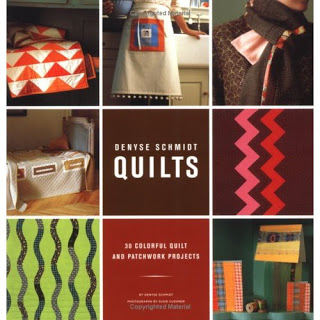We were discussing design books on a list in which I participate. I reviewed, sort of, Johannes Itten’s book, Elements of Color, some time ago. I wanted to mention Sarah Ann Smith’s posts about Steven Aimone’s book Design!: A Lively Guide to Design Basics for Artists & Craftspeople.
Tag: Book Review
The Benefits of a Pattern Book
When I first saw this book, I pooh-poohed it as being just another pattern book. I was, however, struck by the pattern for the heating pad cover. I used a heating pad for months. Throughout those long and painful nights, I would wake up to cold plastic against my skin where the cover had slipped off. Or I would wake up to plastic seams lodged in a fleshy part of my hip or leg. I started to have dreams about making the heating pad cover and different techniques I would use to keep the beautiful cover on the heating pad. Velcro and, eventually, glue dominated some of those dreams.
I couldn’t get that heating pad cover out of my mind so I, finally, checked Denyse Schmidt Quilts out of the library so I could take another look.
At the end of the day it really is just a pattern book, but I decided to buy it because of the way she writes. She does not assume that her readers are morons, like most quilt books. She has a sense of humor (Ready-Set-Sew). The clean, clear lines of the quilts and projects are very restful. Complicated patterns aren’t necessary; simple patterns look great and pack the punch. I also appreciated the clear directions for 3-D items that I have never made before, such as tote bags. I actually feel like I could make a tote bag after reading DS’s directions.
People like Denyse Schmidt should be encouraged, though I would like to see a bunch of her quilts in one book sans patterns. In the meantime I will be satisfied with this book.
Piece O’Cake Amish-Inspired Quilts
I often look through the Piece O’Cake books at stores, sigh and don’t buy them. I love Love LOVE the photos, the authors’ designs and the layout of the books. I would love it if they just wrote a book with photos of all of their quilts in it. I don’t like the patterns. I don’t need or want to make the exact quilts that they have made. My dear friend, JulieZS, author of High Fiber Content, gave me Piece O’Cake’s book Amish-Inspired Quilts: Tradition with a Piece O’Cake Twist. 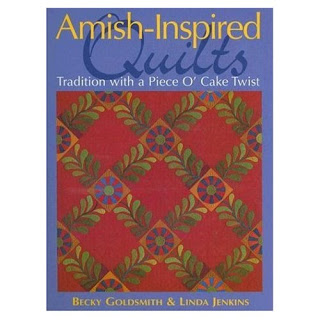
Every now and then, lately, I have had a few minutes to sit and read, so I have started to read it. Normally I don’t do this with quilt books. I look at the pictures and that’s it, under the assumption that all the text is basic and repeats from other books. Thus, I was pleasantly surprised when I started to read Amish-Inspired Quilts. First off, I liked the way Becky talked about her sons in the dedication, but mostly I liked the way they talked about using using solid fabrics.
I used to use a lot of solids. I liked the simplicity and the depth they created in quilts. They can be a bit harder to use if something doesn’t make them stand out. I have gotten away from using solids as I have progressed in my quiltmaking.
The authors say in the first section on color “These quilts feel bold. They often feel contemporary, which is a testament to their classic beauty. The design of the quilt itself is very important when working with solids. Solid fabric has no pattern–the visual texture is smooth. The riot of color that comes with prints, plaids, and stripes is not there. When you use only solid fabric in a quilt, each shape is clearly defined. The structure of the pattern is for all to see.”
I had a strong reaction to the above statement when I read it, because when I used solid fabrics, I was trying to take out some of the many variables of quiltmaking, so I could understand it. As my skills improved, I got away from the simplicity. Perhaps, lately, I have been trying to regain some simplicity by using simple patterns. Consider Thoughts on Dots. 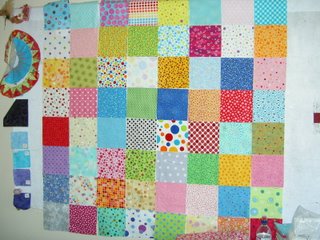
From squares only, I have made it back to triangles with Serendipity Puzzle, but now I wonder if I didn’t go far enough into simplicity. Should I have tried squares and solids? We’ll see. It is never too late.
PIQF 2006: other things we did and saw
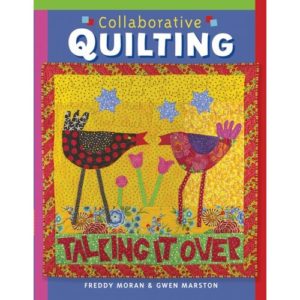
Books and Media: If you haven’t bought the book, Collaborative Quilting by Freddy Moran and Gwen Marston, RUN don’t walk to the nearest quilt shop to buy it. Collaborative Quilting couldn’t be more perfect. It was only $20, had techniques and NO patterns. The BEST part was that it has color photos on at least 85% of the 255 pages. If you love fabric and learning techniques (not patterns) and making FUN quilts and looking at FUN quilts, then this book is for you. This is the perfect book for me! I can wander through it and look at the quilts and the fabric combinations and read the bits on color that Freddy writes, peruse Gwen’s liberating quiltmaking. This is the kind of book that inspires me to be creative. I am going to look out for more Sterling Press books, because I think they are reaching beyond the pattern books on which most quilt publishers are focusing. They are not pandering to the lowest common denominator; they are encouraging us to reach.
We also ordered the Journal Quilt book. It wasn’t ready to bring to the show, so Patricia Bolton of Quilting Arts magazine and Cloth, Paper Scissors offered us (and everyone else, I suppose) free shipping if we ordered it then and there. I can’t give a complete review, because I haven’t seen it yet, but, again, no patterns. Lots of pictures of the journal quilts. I am looking forward to another source of inspiration.
There were a group of Alzheimer’s quilts at PIQF, which were some of the best quilts there. No pictures were allowed, but they had a CD, which we bought.
Fabric and Materials: The Scrappy Appleyard (alas, no website that I could find) can be reached at (702) 806-8918. They were unbelieveably nice to us when we were looking for a certain pink striped fabric. They let us take a photo of one of their quilts and didn’t act like we were taking food out of their children’s mouths for asking. I am not sure why I am so surprised, but the whole (true or not true?) idea of all quiltmakers being friends was highly overrated in the vendor area. The vendors didn’t really seem happy to be at PIQF this year. There were lots of signs saying not to take pictures of their quilt samples. I can understand wanting people to buy the patterns, but the signage seemed very offputting. I am sure there is better terminology. “Please ask before you photograph” provides a way for the vendors to get people interested in their products and makes a connection with a potential customer.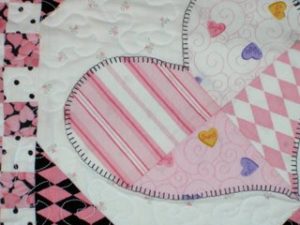
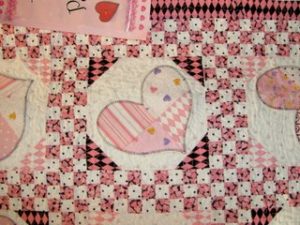
I love the different widths of that pink stripe and also the pink and white diamond. Nobody else knew what the fabric was, but the owner of the Apple Scrapyard did and we were able to find it on the web. We would have called her and bought it from her, but she said she didn’t have anymore. I believe I have a pink quilt in me that is dying to come out. It needs to get in line!
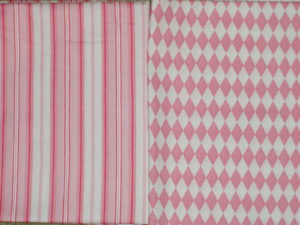 With the information that the Apple scrapyard lady gave us, we were able to find both pieces on the web from a store in Texas. I am glad to have a piece and got that bug out of my ear.
With the information that the Apple scrapyard lady gave us, we were able to find both pieces on the web from a store in Texas. I am glad to have a piece and got that bug out of my ear.
The Good, the Bad and Not the Ugly: On the way home, we stopped at a store in San Mateo called Always Quilting. We had vaguely tried to find the store before, but were in completely the wrong part of San Mateo. The Bad: The store is hard to find! It is in an anonymous office complex with NO signage outside on the street or on the building. My unsolicited suggestion was a sandwich board or something that they could set up on the street. The location seems to me to be big problem in terms of sales. I am not their financial consultant and I hope their online store is making up for the lack of foot traffic. We perservered, however, and did eventually find it. The good part was that there was PLENTY of off street parking. Those office buildings have huge parking lots and with none of the workers there we didn’t have to lug our purchases very far. 🙂 They said that they were planning to move towards the end of the year to a different space. Good plan! I really wish them well. It is nice to know that there is a nice sized store with great fabrics nearby.
The store also looked like a hurricane had hit it. It was a wreck with bolts of fabric every where. Some of it was that they had so much fabric. I am sure part of it was that they had pulled many bolts from the shelves to gear up for PIQF, but I was tripping over fabric and that was not a good thing. I am sure their new space will be better and I look forward to seeing it.
The Good: They have great fabrics and a big space. I found a great group of snowflake-like dots by Moda that we had not seen before. I have already cut pieces of some of them for Thoughts on Dots and have found the colorways to be quite useful for cheering up the piece.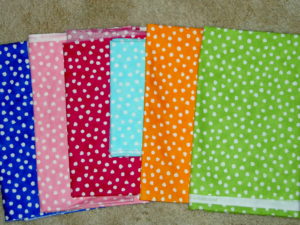
They also have a long arm machine and may be getting a new one. They give classes on how to use the longarm and that appeals to me. While I may not want to longarm all of my quilts, I am interested in the process and think I could work with my quilter better, if I knew more about the process. They will be giving classes after the first of the year and I will try and sign up for one.
Fabric Chores: I got my act together to wash the fabric and St. JCN, kind and generous soul that she is, pressed and folded it all for me.
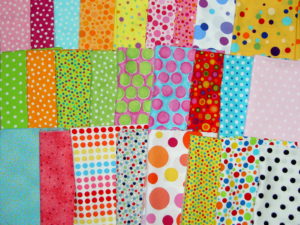
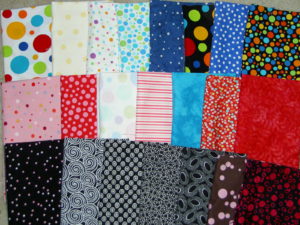
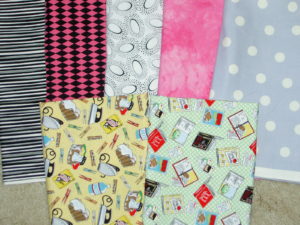
The chores fabrics on the bottom in the photo above I plan to use in the Women’s Work series. You can see Women’s Work 1 at Artquiltmaker.com. Another piece, Women’s Work 2, is still in process. It uses techniques and ideas from a Gwen Marston class I took a few years ago.
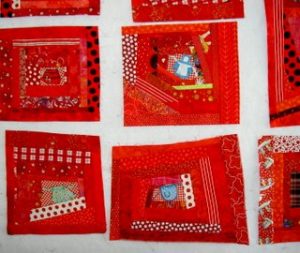
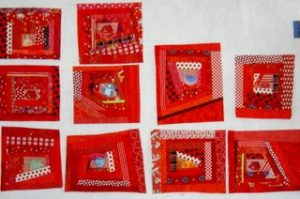 As you can see this series starts with red. Glad I have enough.
As you can see this series starts with red. Glad I have enough.
St. JCN also helped me dig up my front flower bed, get out the bulbs and replant them. We had to buy a few more bulbs, because many had disappeared somewhere unknown and some were rotten. This is the beginning of the landscaping of my yard. This is not something I want to do, but I want it done and St. JCN is good at it and will lead me through it by the hand. HOpefully it won’t be too painful. 😉
Other Thoughts: The show was very crowded and sometimes I get overwelmed with noise and visual stimulation. I thought that, if I were alone, bringing some kind of portable music device (iPod, Discman, Walkman, Muvo, etc.) with your soothing music of choice might be a way of keeping overstimulation to a minimum. It might look a little unfriendly, though.
Another New Book
How can I resist Judy Martin? Her stuff is great! Scraps is Judy’s latest book and I think this is the answer to my comment in a recent post about Knockout Blocks and Sampler Quilts, Martin’s previous book. Scraps is a project book. Many of the blocks used in the quilts seem to come from Knockout Blocks and Sampler Quilts, especially noticeable in Cooperstown Stars. She has patterns for every skill level and the directions seem to be clear and well illustrated. Though I dislike sections on “how to make a quilt”, Judy’s is very well done and I often read this section in her various books, because I always seem to learn something. Three-of-a-Kind is similar to a free Block of the Moment on Judy’s website called Celtic Squares. She has great BOMs and I keep them all for future when I have skads of spare time.
Various and Sundry (aka more thoughts on dots)
At the drugstore, I happened upon BH&G’s Spring 2006 issue of Quilts and More. I had never seen this magazine before and was immediately drawn to the quilt on the cover. There should be no suprise that this quilt was made with dot fabrics. The block is called, according to the magazine, at least, Dolly Madison Star. I haven’t looked it up in resources I consider to be more reliable, so I can’t say at the moment. I tried to find a picture of the quilt on the web, but the BH&G people don’t have it on their website so you’ll have to trust me that it is a seriously cool quilt. Excellent use of many dot fabrics. I would actually consider making a quilt similar to this, because it is the perfect quilt for a grey, wet and cold winter in a life-sucking beige house.
Dots are definitely on the mind, but so are some new books that I have bought or received as gifts.
In general I don’t like books that are mostly patterns. I like books with lots of great pictures that depict quilts that show me something new and inspire me to think outside of the box.
The Modern Quilt is a pattern book, but the designs are innovative and fun. They are supplemented by smaller pictures showing different colorways. There are bits about putting together colors. The best part is that the authors (and publishers, I suppose) had the guts to include patterns with curves and other odd shaped pieces. This tells me that they are not condescending to the lowest common quilting denominator. YAY!!! Some of the piecing reminds me of Ruth McDowell’s Piecing book.
Ruth McDowell’s Fabric Journey is another recent acquisition. She is, without a doubt, my favorite quiltmaker. Jane Sassaman and Judy Martin run a close second, but I love Ms. McDowell’s nearly exclusive use of piecing and her nearly exclusive use of commercial fabrics. She really teaches, and demonstrates in her quilts, the extraordinary things that a quiltmaker can do with piecing and celebrates good technique. Fabric Journey gives insight into several of Ms. McDowell’s quilts. Ms. McDowell discusses several of her quilts, the inspiration, the use of fabric and various piecing techniques. This is not a pattern quilt per se, but the reader can use the descriptions to create their own designs. Again, Ms. McDowll does not condescend to the reader. She gives the impression of assuming that, with practice, anyone can piece the way she does.
Whimsical Quilts by Carol Burniston was a total impulse buy at Thimble Creek. The reason I bought it was because it had a great and fun pattern for appliqued flamingos. You never know when you might need a pattern for flamingos, right? It is a pattern book, but it does have fun colors and lots of good photos. The other quilt I like in the book is called, oddly enough, Hot Tamale Sunflowers. There is also a fun sheep quilt that I would never make, but it is cute. The books also includes a fish qult with a lot of possibilities. The book makes me smile, so it was worth the price.
With my birthday money from RBL, I bought Mary Schafer American Quilt Maker by Gwen Marston. I have a number of Marston’s books and really enjoyed the workshop on Libertated Quiltmaking I took from her a few years ago. The quilt I made as a result of the techniques I learned in the class can be seen on Artquiltmaker.com. The Mary Schafer book has nothing to do with Liberated Quiltmaking, however. It is a history type quilt book depicting the work and collections of Mary Schafer. The quilts are classic in style, though many of them have a twist, such as Grandmother’s Pride, 1980, pg. 111. I also like the pictures of Schafer’s templates, patterns, family photos as well as the numerous color photos of quilts scattered throughout the book.
For my birthday, JZS was kind enough to buy me Textile Designs from Thames and Hudson, which has been on my Amazon list for an eternity. This is a book that shows the history of textlie designs for the past 200 years. It is great to look at the variety of patterns through 200 years. I particularly like some of the futuristic patterns, such as those in the Geometric section on page 199 and those on page 185 and 186. It occured to me that, if I found the perfect pattern on one of the pages, I could scan and print it to fabric for personal use only, of course. Fabric designers should look at some of the 20th century designs in this book recolor and reprint them. Pattern designers seem to focus on the Civil War type colors and patterns at the moment and those are just too boring (in design) and too depressing (in colorways) for me.
Index to the Laura Wheeler Quilt Blocks is one of a series of indexes that Rose Alboum from West Halifax, Vermont is putting together. This index is one of the ‘block dictionary’ type books that I love. It has the name, number and a sketch of all the blocks designed by Laura Wheeler. There are no templates or patterns, but the blocks could easily be designed in EQ5 or by some other pattern design method (e.g. normal drafting). Perhaps Ms. Alboum will cut a deal with The Electric Company and EQ will issue ancilliary CDs with these patterns on them! Again, it is great to see the old patterns because they have odd shaped pattern pieces. I look forward to seeing more of Ms. Alboum’s work.
Another impulse book buy, while I was in Seattle in January, was Paper Piecing Picnic by the editors and contributors of the QNM and Quiltmaker magazine. Again this is a pattern book, but there are some nice photos, especially of Indian Wedding Ring, page 72, Dandelion, page 67, Trip to New York, page 63, and Fireworks, page 43. I also like the row quilt layout of Sunflowers, page 52, but am not so excited about the square-ness of the actual sunflowers. Also the mathematical relationship of the center to the petals seems a bit off to me, but it could be the photo in the book. The photos in this book are clear and there are many of them. The instructions, if you like paper piecing seem to be easy to understand. I also like the bright colors.
B&B sent me Kaffe Fassett’s Museum Quilts, also for my birthday (what a bonanza this year! WooHoo!!!). For Fassett, it is all about the fabric and I love the many fabrics that he uses and the combinations that he comes up with. The designs/patterns have the feeling of classic quilts, but the fabrics and details make them fresh and new. I also love it that he is not afraid to mix color and pattern. There is always more fabric, so why be concerned that patterns might clash? I like the way a number of the quilts reflect mosaic floors. Unfortunately, the publisher seems to have required the ubiquitous “how to make a quilt” section. I don’t know why publishers just don’t refer to some other more complete book on quiltmaking rather than forcing authors to waste 30-50 perfectly good pages on an inadequate section on how to make a quilt. Not that the directions in this book are poor, but making an entire quilt, no matter how good the directions, cannot, IMO, be explained in 30-50 pages. The space would have been better used for a few more quilts or a gallery section.
I admire Sally Collins precision work a lot and her latest book is another that I purchased with birthday money. It is called Borders, Bindings & Edges. First, there are excellent pictures of Collins’ quilts, but include other artist’s work as well. This is a book about techniques. Collins believes that precision piecing is important and this book thoroughly explains how create different types of borders, including mitered corners. She also discusses bindings (thus the title) and has lengthy discussions on different types of finishing. If you want to improve your technique, I would recommend this book, as well as one of previous books, The Art of Machine Piecing: How to Achieve Quality Workmanship Through a Colorful Journey and Small-Scale Quiltmaking: Precision, Proportion, and Detail.
Quilt Visions 2004 is a catalog of the Visions show, held in San Diego every other year. This is my perfect book, in many ways: no patterns! I like Cacti I by Nancy Cordry, Autumn Splendor by Nelda Warkentin and Weavings 12 by Marie Castle Wing, but am annoyed by the ‘quilts’ that look like photographs. I could discuss the “is it a real quilt” issue with people for years, but the bottom line for me is that if there is no piecing or applique, then it is tending to not be a real quilt. This, of course, begs the question of wholecloth quilts, but perhaps they are not quilts either? For photographic reproduction ‘quilts’, I just don’t see the point. Take a photo and move on, IMO. This book comes with a CD, which I haven’t had the chance to review yet. I like the trend towards including CDs with books and guilds creating CDs of their shows (go to Content Innnovations, LLC’s Website to buy a couple of CDs from local Northern California shows). It makes the shows less ephemoral to me.
Aja gave me Art Quilts: A Celebration for Christmas. Again, this book has no patterns or project sheets. It is a catalog of 400 art quilts from 1995-2003 arranged by year. I love it! First, I am happy that they are not telling me how to make these quilts. Second, I love the organization. Someone (a librarian, maybe??) got the publisher to organize the quilts in a way that makes sense. This organization makes it easy to see how art quilts have evolved. Third, I like the selection of quilts chosen. I can appreciate the wide variety of techniques, including photograph type quilts, when there are a wide variety of techniques shown and you can see the photos in context. I hope the publisher does well enough with this edition to do future updates of this book. Buy Art Quilts: A Celebration to show support!
Karen K. Stone’s book Quilts was one I bought when I bought the companion software from the Electric Quilt Company last year. It is a pattern book, but there are a few photos that show her inspiration and the close-ups of the blocks are so good that it makes the pattern part worth it. Her fabric combinations remind me of Kaffe Fassett’s.
Judy Martin is one of my favroite block designers. She is prolific, supports herself with her own business and doesn’t condescend to her readers. Sense a trend here? The blocks she designs are classic with a twist. She also seems to want people to try out odd shapes and teaches how to create them. Her book, Knockout Blocks and Sampler Quilts has an amazing number of new block designs and quilt layouts to try. It is, however, a bit of a disappointment. Note: definitely still worth purchasing! The designs are great, extremely creative and fresh, but there are no actual fabric quilts shown in the book. It looks like all the quilts pictured are computer generated. I can appreciate the speed with which one can create computer generated designs and, thus, produce a book, but I want to see actual fabric quilts made with the patterns. I would love to see an update of this book, or a companion book with actual fabric quilts shown. I bet Judy could find fans to create blocks and quilts that could be used in the updated version of the book, if she doesn’t have time to do all the sewing. I’ll sign up for a block or two! If you like blocks, this book is still a wonderful resource.
Cookies and Quilts is also a Judy Martin book which combines quilt patterns with decadent chocolate recipes. This book has lots of photos of quilts. Not all of them are star quilts. It is primiarly a pattern book and there are no sections with blocks only. I haven’t tried any of the cookie recipes, but the photos of the cookies look delicious.
